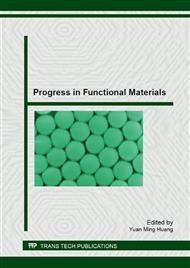p.73
p.77
p.81
p.85
p.89
p.93
p.97
p.101
p.105
Experimental and Simulation Study of Microhardness Indentation of Solid Oxide Fuel Cell Using Progressive Damage Material Model
Abstract:
A finite element model with progressive damage material properties is proposed to study the mechanical behavior of Ni-8YSZ/8YSZ half-cell structures under Vickers indentation tests. The simulation results show that the simulated hardnesses of the as-received anode (NiO-8YSZ with 12% porosity) and the reduced anode (NiO-8YSZ with 36.68% porosity) samples were 2.54 GPa and 0.66 GPa, respectively, which are fairly in agreement with the experimental data. The interface delamination between the anode layer and the electrolyte layer was investigated by varying the mechanical properties of the interface between the two layers. The parametric study shows that a weak interfacial layer (with a low Young’s modulus) may cause potential failure due to delamination.
Info:
Periodical:
Pages:
89-92
Citation:
Online since:
January 2013
Authors:
Price:
Сopyright:
© 2013 Trans Tech Publications Ltd. All Rights Reserved
Share:
Citation:


